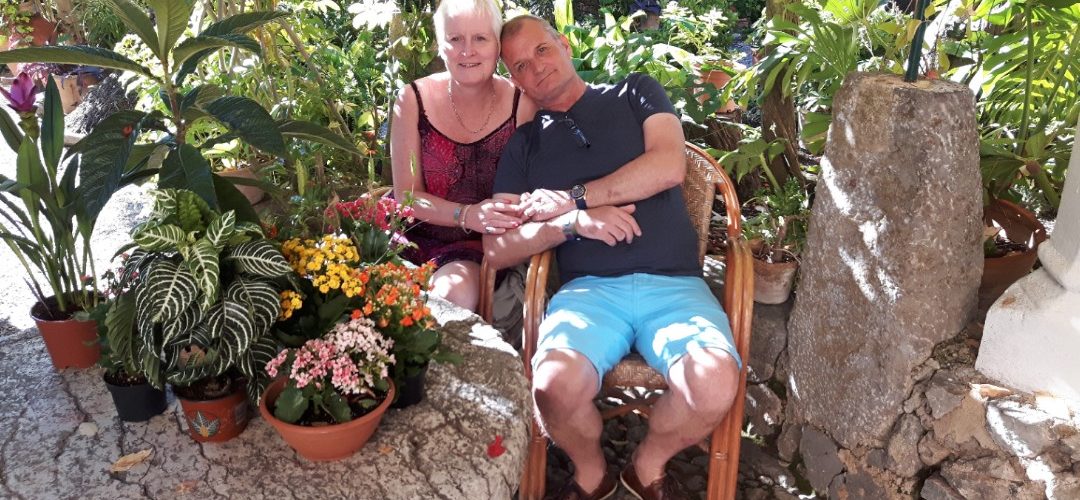Why we fly
Phil’s Story

“Despite the amazing efforts of everyone else who attended me, I don’t think I’d be alive today if I wasn’t put into a coma. My cardiologist has told me that my chances of surviving were only 0.15 per cent. It really is a miracle that I’m still here,” he says.
Lying on his bedroom floor, after suffering a cardiac arrest in his sleep, Phil Hulland showed no signs of life for 26 minutes.
He had been given CPR – firstly by his wife Mandy and then by paramedics – and shocked with a defibrillator twice before there was a flicker of activity on the electrocardiogram machine monitoring his condition. This signalled the return of a weak pulse and the start of a long journey towards recovery.
To stabilise Phil before going to hospital, the Derbyshire, Leicestershire & Rutland Air Ambulance doctor and critical care paramedic present put him into a medically induced coma.
This is normally only carried out in a hospital environment but the air ambulance crew had the clinical expertise to carry out the procedure which Phil – from Spondon, Derbyshire – credits with saving his life.
“Despite the amazing efforts of everyone else who attended me, I don’t think I’d be alive today if I wasn’t put into a coma. My cardiologist has told me that my chances of surviving were only 0.15 per cent. It really is a miracle that I’m still here,” he says.
The DLRAA doctor and critical care paramedic had arrived at Phil’s home in the charity’s critical care car which responded to 55 per cent of calls last year.
The car was used for this mission instead of the helicopter due to the time of day – the helicopter is not available early mornings or during the hours of darkness so having the car as well means there is 24 hour critical care cover available.
It was decided to put Phil into an induced coma to give his heart and brain a chance to recover. Even with good CPR –as happened in Phil’s case – there is reduced blood flow to the brain and it can take several days for it to fully recover.
The air ambulance team then accompanied Phil in the land ambulance to Royal Derby Hospital where he spent a month recuperating and having further treatment.
During this time he was transferred to Nottingham City Hospital to have an implantable cardioverter-defibrillator (ICD) fitted and the device now regulates his heart 24 hours a day and will provide an immediate shock to the heart should Phil ever have another cardiac arrest.
When Phil had the cardiac arrest in August 2017 he was asleep in bed just before 8am when he suddenly gasped, lurched forward and lay back down again.
Mandy, who had been trained in CPR (cardiopulmonary resuscitation) called 999 and pulled Phil onto the floor to start working on him. She was supported by the East Midlands Ambulance Service call handler who talked her through the process until the land ambulance arrived.
“If Mandy hadn’t been lying in that morning and had got up 15 minutes earlier like she normally did, I would have died. She did CPR on me for about ten minutes and kept me going,” says Phil.
Mandy adds: “I just went into robot mode. I didn’t really panic, I just knew I had to get him on the floor and do as much as I could to stop him dying.”
Phil’s only side effects since it happened are short-term memory loss and chronic tiredness.
“It could be so much worse and I am grateful that’s all I suffered,” he says.
Now working as a part-time factory floor manager, Phil used one of his non-working days to visit the DLRAA base at East Midlands Airport to thank the crew who treated him.
He was reunited with critical care paramedic Karl Bexon who was on duty with Dr Matthew Wyse when Phil was put into the induced coma.
Phil and Mandy handed over gifts for them both and a thank you cake to be shared with all the local air ambulance crew.
“It was a team effort to save my life and I am very lucky that everyone came to my aide so quickly. It’s important to both of us to be able to shake hands with those people and say thank you. It’s the least we can do,” says Phil.
“I hope my story inspires anybody who doesn’t know how to do CPR to find out. I am living proof that lives can be saved by CPR and defibrillators – and everybody should know how to use both,” he adds.
Air ambulance Doctor Matthew Wyse explains:
“The best chance of survival for a cardiac arrest recognises there is a chain of survival that involves dialling 999 for help, good CPR, using a defibrillator to shock the heart and excellent critical care to support the patient until they recover.”
“The team from DLRAA have a role to play at every step in the chain of survival but especially in providing exceptional critical care at the scene of an incident – just like we did for Phil.”
